lecture1
advertisement
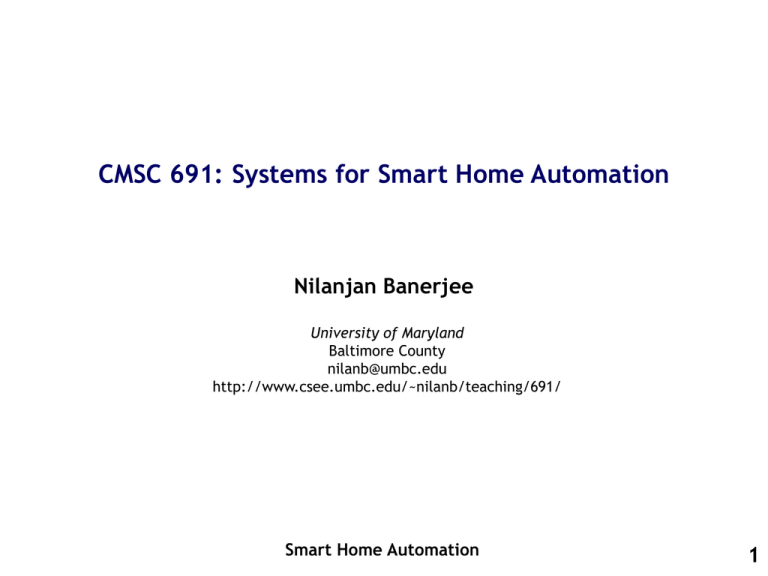
CMSC 691: Systems for Smart Home Automation Nilanjan Banerjee University of Maryland Baltimore County nilanb@umbc.edu http://www.csee.umbc.edu/~nilanb/teaching/691/ Smart Home Automation 1 Course inspired by the following Microsoft Vision http://www.youtube.com/watch?v=Wh-LV28Quqs 2 Homes are the epicenter of sensors/analytics/automation Slide credit: Ratul Mahajan, Accelerating innovation in Home Technology Homes are the epicenter of sensors/analytics/automation Tasks (software) Energy monitori ng Alerts w/Phot os Climate control Keyless entry Devices (hardware) Slide credit: Ratul Mahajan, An Operating System for the Home Remote lock What sort of sensors are used in homes nowadays? Door and windows sensors Clamp meters for whole home energy consumption Energy meter for appliance energy consumption Multisensor for temperature, humidty, and motion detection 5 What sort of sensors are used in homes nowadays? Stick-N-Find to locate items in the home 6 What sort of sensors are used in homes nowadays? Vibration sensors and light sensors Designed to catch emotions when using a couch* Kinect/IP Camera *Mennicken et al., EmotoCouch: Exploring the Emotions of Furnitures 7 Some commercial products. 8 Gap between potential and reality in Smart Home Automation Envisioned by many researchers and companies Struggling to break into the mainstream – Despite commercial availability since 1970s Slide credit: Ratul Mahajan, An Operating System for the Home Understanding the gap • Pre-Study of homes with modern automation – 31 people across 14 households – Enjoyed convenience, peace of mind and control – But, had difficulty in two key areas: Poor extensibility Management pain o r Adding devices and tasks Access control Slide credit: Ratul Mahajan, An Operating System for the Home Gap – Details • Hardware inflexibility: networking wires, lowvoltage wiring • Extensibility: Organic growth • Management: Security – Currently the choice is between security and inconvenience (guest / remote access) Slide credit: Ratul Mahajan, An Operating System for the Home A primer into the platform we would use: Lab-of-things Home store App UI Security Climat e …….. Home hub Z-Wave, DLNA, WiFi, etc. Ok! Tell me what the course contents are • Primer into C# • basics of C#, Visual Studio Professional • Introduction to Lab-of-things • HomeHub: Based on Home Operating System • Cloud components • Programming using Lab-of-things [Core of the class] • Concept of Drivers • Concept of Scouts • Concept of Apps • Programming Specific Sensors [Core of the class] • Energy meters, Window and door sensors, Multisensor • Proximity Sensors • Kinect • Cloud services [Core of the class] • Storage, webservices • Control • Smartphone applications (simple) 13 Is this course for me? • Should have knowledge of object-oriented programming. • Should have working knowledge of networking and operating system concepts • This is not a book-oriented course. Your creativity will be tested in the assignments, class discussions, and final projects. 14 How will I be graded? • Assignments in groups of two (2-3 total) (30 points) • Building simple LoT drivers and applications. • In-class midterm (15 points) • Testing design skills and mobile programming skills • Final project groups of 2 (45 points) • Hopefully we will have a poster/demo session • In class discussions (10 points) • Discussions related to research papers in the area. 15 Assignments • Two to Three assignments on design problems • Involve coding using Lab-of-Things • Groups of two solving the assignments • Grading • Source code (7 points) • Video --- every group will make a video of their assignment and upload it on youtube. (3 points) • I will share the video and everyone in the class votes on it (best video gets an extra 5 points on the assignment) 16 Midterm • In-class midterm • Design and coding problems • Grading • 15 points towards final grade 17 Group Project • Will have to do some coordination for the project. • There is a $500 first prize for the BEST project, sponsored by Microsoft Research. Here is what I am envisioning for the final poster/demo session http://research.microsoft.com/en-us/um/redmond/projects/homeos/homeos-demos.htm 18 Group formation semantics • You should create a google site per group • Google site should be *just* shared with me and the grader • My email address (nilanb@umbc.edu) • Grader to be decided • The google site would form the portal for the following. • Submitting your assignments. • Keeping track of your final projects. 19 Lecturing style Demo-oriented Lecturing bring your laptops if you have one Discussions on interesting papers in the area. 20 Resources you will need • Visual Studio professional • UMBC has a license of Visual Studio and it is installed in CSEE classrooms ITE 240, 242, 375. • CSEE has renewed its Dreamspark license. You should be able to download it on your personal computers • To start, you can download the Visual Studio professional trial version. You can download a virtual machine if you do not have Windows on your personal machine • We will work with real sensors (I will provide them) • Energy meters, multisensors, door and window sensors, proximity sensors, kinect etc. 21 Administrivia… • Course webpage and reading list • www.csee.umbc.edu/~nilanb/teaching/691/ • My email id: nilanb@umbc.edu • Discussion Group • Piazza • Class hours: 1:00pm – 2:15 pm (Mon, Wed) • Office hours: 9:45 – 10:30 (Monday) or by appointment • Grader: TBD • Office hours: TBD. • Come and talk to me if you • To discuss project ideas • Group formation and other semantics 22 Next Lecture • Start with Primer on C# 23



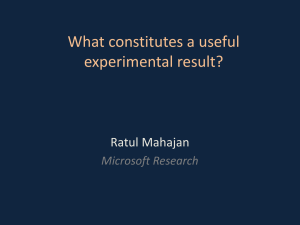
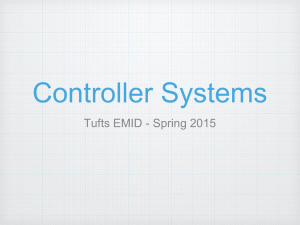

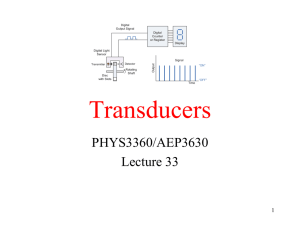

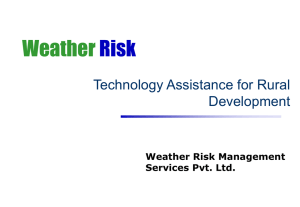

![Transducers_1[1]](http://s2.studylib.net/store/data/005329047_1-b90da3eabfa98717d13e735055577e1f-300x300.png)